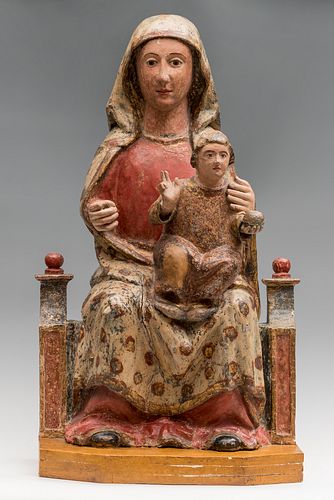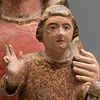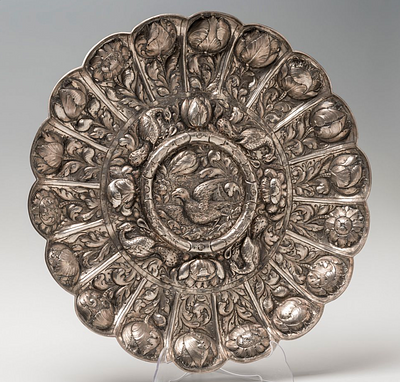Catalan school; XV century. Carved in polychrome wood, gilded.
Lot 87
About Seller
Setdart Auction House
Carrer Aragó 346
Barcelona
Spain
Setdart Subastas was born in 2004 and is currently the first online art auction in Spain with solidity, prestige and reliability guaranteed by our more than 60,000 users. Setdart has a young, dynamic and enterprising team ready to successfully manage the purchase and sale of art works through custom...Read more
Categories
Estimate:
EUR€12,000 - EUR€13,000
$12,903.23 - $13,978.49
Absentee vs Live bid
Two ways to bid:
- Leave a max absentee bid and the platform will bid on your behalf up to your maximum bid during the live auction.
- Bid live during the auction and your bids will be submitted real-time to the auctioneer.
Bid Increments
| Price | Bid Increment |
|---|---|
| EUR€0 | EUR€10 |
| EUR€200 | EUR€25 |
| EUR€500 | EUR€50 |
| EUR€1,000 | EUR€100 |
| EUR€3,000 | EUR€200 |
| EUR€5,000 | EUR€500 |
| EUR€10,000 | EUR€1,000 |
| EUR€20,000 | EUR€2,000 |
| EUR€50,000 | EUR€5,000 |
About Auction
By Setdart Auction House
Jul 13, 2021
Set Reminder
2021-07-13 07:00:00
2021-07-13 07:00:00
America/New_York
Bidsquare
Bidsquare : DECORATIVE ARTS XV-XIX
https://www.bidsquare.com/auctions/setdart-auction-house/decorative-arts-xv-xix-7201
Setdart Auction House sofia@setdart.com
Setdart Auction House sofia@setdart.com
- Lot Description
Catalan school; XV century. Carved in polychrome wood, gilded. It presents restorations on the base and inscriptions on the back. Measures: 77 x 46 x 26 cm. Religious image carved in wood and polychrome, representing Mary seated on a throne, with the Child in her lap. In the area of the back, located at the base of the throne you can see an inscription that says that it is the Virgin of Montserrat, it is true that iconographically, in the figure you can see details similar to this dedication. An example of this is the presence of the Virgin seated, as a throne for Jesus, her hand extended and holding a ball, representing the world, although it is true that in this particular case the ball is held by the Child. Another similar feature is based on the gesture of blessing the Nile, however, the Virgin does not wear a crown, her clothes are not golden and the skin flesh tones are whitish, in contrast to the Virgin of Montserrat, colloquially known as the Moreneta. In this work the Virgin Mary is nothing more than the seat of divinity; she is not presented as the mother of God, so there is no affective relationship between her and the Child. In fact, at this time the Virgin is not yet a relevant character within the Church. These Virgins throne of God were always made in a size between 50 and 100 cm in height, mainly in carved wood, and in them the protagonist is always the Child, despite the difference in size with his mother. Jesus always appears as we see here, blessing with his right hand and holding a ball in allusion to the universality of the Christian religion, or sometimes holding a book referring to the Holy Scriptures. The Child always appears facing the viewer, and normally in the center, although here he is slightly displaced to one side, in a more natural position that indicates a clear formal advance. As we have said, there is no affective relationship between Mary and Jesus, but rather they turn their backs to each other and look directly in front of the viewer. The Virgin is presented in these "Sedes Sapientiae" dressed in tunic and mantle, sometimes with a headdress. The clothing of these Virgins is completed by pointed shoes, black or of another very dark color, which are always visible. The Child, on the other hand, usually appears barefoot. He also wears a tunic or mantle and, as in Mary's clothing, deep and very parallel folds can be seen in his. In this type of carving the Virgin usually appears with empty hands, on a throne that serves as a seat or, at most, on the Child, as we see here. However, the fact that she carries an object in her right hand, an apple in allusion to original sin, links directly back to the Gothic, when it will be common for the Virgin throne of God to hold some element in her hand.
- Shipping Info
-
In-house shipping available. Please inquire at admin@setdart.com.
-
- Buyer's Premium



 EUR
EUR CAD
CAD AUD
AUD GBP
GBP MXN
MXN HKD
HKD CNY
CNY MYR
MYR SEK
SEK SGD
SGD CHF
CHF THB
THB
















